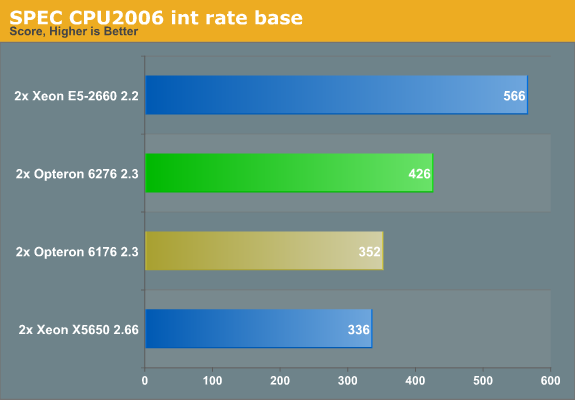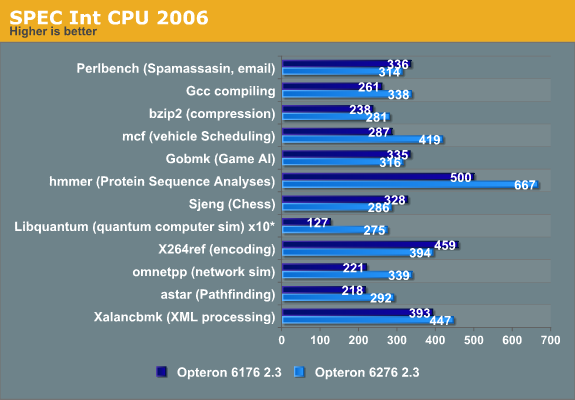The Bulldozer Aftermath: Delving Even Deeper
by Johan De Gelas on May 30, 2012 1:15 AM ESTNext stop: SPEC CPU2006 Int Rate
There is no denying that SPEC CPU2006 was never one of our favorite benchmarks in the Professional IT section of AnandTech. Although it is the standard benchmark of most CPU designers and academic researchers, it is far from a real world benchmark for most professional IT users.
For starters, a typical SPEC CPU2006 benchmark consists of running as many SPEC CPU2006 instances as there are cores available in the machine. The SPEC CPU2006 instances run completely independently from each other, so there are much fewer locks or other synchronization mechanisms at work: the benchmark scales almost perfectly as long as there is enough bandwidth available. Unfortunately, that is not how the majority of business software behaves: databases have high locking overhead and most applications need some synchronization.
Secondly, most of the subtests are related to gaming and simulations (HPC). Typically these applications are much more processing intensive and achieve a higher IPC than your average business application.
Lastly, the source code of the SPEC CPU2006 tests is compiled with extremely aggressively tuned compiler settings and compilers that are less used in the rest of the IT world. Few SPEC CPU2006 results are compiled with gcc and Microsoft's Visual Studio, for example.
However, it would be a step too far to call SPEC CPU2006 useless. From a high level perspective, the scores of SPEC CPU2006 show a strong correlation with L2/L3 cache misses, cache latency, and to a lesser degree branch prediction, just like many business applications. Given similar platforms (like Intel Nehalem and AMD's Shanghai), the CPU SPEC2006 Int score gives a vague idea of which CPU has the most raw integer crunching power, although it overemphasizes memory bandwidth and core count.
To understand the weaknesses and strengths of a certain CPU architecture, even in server workloads, there is no better test than SPEC CPU2006. The first reason is that it has been profiled by so many different people from academia to engineers. If we zoom in on the subtests we can derive a lot of information as we know exactly how these applications behave: there have been lots of performance characterization papers going into great detail.
The second reason is that SPEC CPU2006 tests are compiled with the most optimal compilers and compiler options available at a certain point in time. This gives us some insight into the "real" (e.g. future) potential of a processor. We can exclude the possibility that a processor performs badly because some legacy piece of code is detrimental to the performance. If the CPU cannot score well with these kinds of binaries, it never will!
Auto-parallelization made the normal single-threaded SPEC CPU benchmarks very hard to read. We turn to the rate version instead. Since it scales almost perfectly, it is relatively easy to deduce single-threaded performance from the SPEC rate numbers--on the condition that cache interference and bandwidth bottlenecks do not blur the picture too much, so we have to be careful with those benchmarks that miss the L2 cache a lot. The current CPU2006 int scores are as follows:

The Xeon E5 is the most efficient clock for clock, core for core. But let us compare the Opteron 6276 (2.3GHz, 16-core Bulldozer) and the Opteron 6176 (2.3GHz, 12-core Magny-Cours) in the subtests.

You can immediately derive from these numbers that the "Bulldozer" architecture has a very different architecture profile than Magny-Cours (which was based on the improved Barcelona architecture, Istanbul). Libquantum, omnetpp and mcf show larger performance boosts than you might expect from the 33% higher corecount. These benchmarks show that in some scenarios, Bulldozer can even increase the IPC compared to its predecessor.
We also notice that Bulldozer has some serious weaknesses compared to its predecessor, as performance decreases in the Perlbench, the game AI (gobmk), the chess (Sjeng), and the x264 encoding subtests. And although it is not uncommon that a new architecture fails to beat the previous architecture in every benchmark, it is not a good sign that even a 33% core count cannot overcome the IPC decrease in a very good scaling benchmark. If we try to understand what makes these subtests different from the others, we can get an idea of what kind of software makes Bulldozer choke. This in turn can help us to understand if relatively small tweaks can help future Opterons.










84 Comments
View All Comments
Zoomer - Thursday, May 31, 2012 - link
True. It's probably better out way back then, but synthesized, than to come out maybe next year with all their lovingly fully customized, hand placed transistors. That's if they don't go bankrupt first.wolfman3k5's probably going to call nVidia, 3dfx, ATi (then), most FPGA program design houses, etc, lazy, too.
misiu_mp - Monday, June 11, 2012 - link
A large margin of error means that you have a lot of space to make errors with little consequence.You meant of course that engineers have small margins of error in their work.
500MM - Wednesday, May 30, 2012 - link
http://images.anandtech.com/graphs/graph5057/42770...If lower was better, AMD would have one kickass CPU. The caption is wrong.
JohanAnandtech - Friday, June 1, 2012 - link
Fixed, thx!weebnuts - Wednesday, May 30, 2012 - link
The problem with all these benchmarks is that most organizations are going to be using this is Xen or Vmware uses. The idea is that with more cores, you can run more VM's especially if you are trying to implement Virtual Desktops. How do the processors compare when you are loading the server to 80-90% capacity with lots of VM's? That's a real world comparison I want to see.Iketh - Wednesday, May 30, 2012 - link
I was dying for information like this. Thank you!And as for that quote on the first page by Iketh, that guy is a genious!! :D
Aone - Thursday, May 31, 2012 - link
1) Maybe i missed something but, Should "Higher is better" be for "Data Cache hitrate", i.e. opposite to cache misses?2) And on the chart "L2 Cache hitrate", is it correct that "Opteron 6276" tag is shown on first line while "Opteron 6174" on the last line? I thought Opteron 6174 was faster in MS SQL than Opteron 6276.
mrdcook - Thursday, May 31, 2012 - link
There are a few new instructions in Bulldozer's architecture that, for certain specific computations, can make it 10X faster than Intel. For example, FMA. An FMA does a multiply and then an add as one instruction, rounding only once. Combining the multiply and the add isn't such a big deal (and in many cases can even be counter-productive), but rounding only once is very important in some cases.For example, assume you have 3 digits of accuracy and want to calculate (1.23 * 2.31 - 2.84). Without FMA, you calculate Round(1.23 * 2.31) = 2.84, then you calculate Round(2.84 - 2.84) = 0. With FMA, you calculate 1.23 * 2.31 = 2.8413, then you calculate Round(2.8413 - 2.84) = 0.0013. While that may seem contrived (it was!), the difference is significant in certain simulations and calculations.
When doing math, computers have a very specific level of accuracy -- a certain number of digits of precision. If you want your simulations to come out right, you have to take these limits into account. Learning how to account for the computer's rounding errors is a bit of a black art.
Mathematicians design algorithms in terms of matrix multiplications and dot products, and if you translate those algorithms directly into computer multiplications and additions, you tend to end up with a lot of cancellation errors like the example given above. You can hire a computer science grad student to rework your algorithm to not lose accuracy, but that is expensive and has to be done for every new algorithm. Or you can use an FMA for the dot products and the matrix multiplications (the high-accuracy dot product and matrix multiplication libraries already do this).
FMA in software is slow. Single-precision emulated FMA isn't too bad since you can use double-precision to help with the hardest bits of the emulation. The result is that you can do one fmaf in about 4X the amount of time it would take to do a single a*b+c. However, SSE2 allows you to do 4 a*b+c at a time, so emulated single-precision FMA ends up being about 15X slower than optimized SSE2 non-fused multiply-add. Double-precision is harder, taking about 10 times longer than a single a*b+c, so it ends up being 20X slower than non-fused multiply-add.
Admittedly, the target market for FMA is probably smaller than a breadbox, but those who need it really need it. And as it becomes more common, it'll only become more important. For now, since only Bulldozer has it, nobody is going to care.
BaronMatrix - Thursday, May 31, 2012 - link
There are admittedly only two viable X86 licensees in America and one of them sucks...shodanshok - Thursday, May 31, 2012 - link
Hi Johan,first of all, let me thank you for your wonderful analysis on Bulldozer architecture. I read it with great interest.
However, I think that you left out a very important thing to mention: L1/L2 cache read/write bandwidth. Especially for L2, while latency is an important thing, throughput can be an even more crucial one.
The key point is that Bulldozer has an write-through L1 cache, so all L1 writes are more or less immediately broadcasted to L2 cache. Some small writes can be effectively cached inside a write-back combining buffer called Write Combining Cache (WCC), but this cache is only 4KB in size per the entire module. So, streaming writes will immediatly fill the WCC and bring down L1 cache speed to L2 levels.
This can really hamper CPU performance. Obviously, AMD went this road for some understandable reasons, however, the WCC is really too small to cache much data and the L2 is way too slow to efficiently serve L1 write requests.
This bring us to another point: L2 cache is slow. Comparing this with the super-fast (but much smaller) L2 Intel cache, it has no hope; it is more or less at Intel's L3 level.
Here you can find my analysis of AMD Bulldozer architecture: http://www.ilsistemista.net/index.php/hardware-ana...">AMD Bulldozer analysis
Note that, while I collected and normalized data from multiple web site, I left very clear what was the original reference (so that you can easily verify my data).
Thanks.